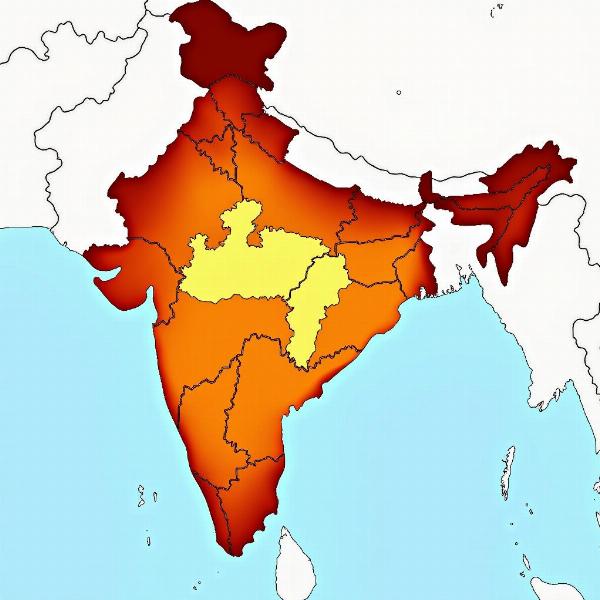Geothermal energy, or “भूतापीय ऊर्जा” (bhūtāpīya ūrjā) in Hindi, harnesses the Earth’s internal heat for various applications. This renewable energy source provides a consistent and sustainable alternative to fossil fuels, contributing to a cleaner environment and reduced carbon emissions. Understanding its meaning and potential is crucial for a sustainable future.
What Does Geothermal Energy Mean?
Geothermal energy literally translates to “earth heat energy.” It refers to the heat contained within the Earth, originating from its formation and the radioactive decay of minerals. This heat is stored in rocks, soil, and underground water reservoirs. We can access and utilize this heat for various purposes, including electricity generation, heating buildings, and industrial processes. “भूतापीय” (bhūtāpīya) signifies “related to the Earth’s heat,” emphasizing the source of this energy. Understanding the meaning of geothermal energy in Hindi allows us to appreciate its significance in the Indian context.
How is Geothermal Energy Harnessed?
Geothermal power plants use steam from underground reservoirs to drive turbines and generate electricity. Geothermal heat pumps utilize the relatively constant temperature of shallow ground to heat and cool buildings. Direct use applications involve using geothermal fluids for industrial processes, agriculture, and balneology (therapeutic bathing).
Geothermal Power Plants: Generating Electricity
Geothermal power plants tap into high-temperature geothermal reservoirs, typically found at depths of several kilometers. Wells are drilled to access these reservoirs, and the steam or hot water is brought to the surface. The steam then drives turbines connected to generators, producing electricity.
Geothermal Heat Pumps: Heating and Cooling
Geothermal heat pumps utilize the relatively stable temperature of the ground a few meters below the surface. These pumps transfer heat from the ground to buildings in winter and from buildings to the ground in summer, providing efficient heating and cooling.
Direct Use Applications: Versatile and Efficient
Direct use applications involve using geothermal fluids directly for various purposes. These include heating greenhouses, aquaculture, industrial processes, and district heating systems.
Geothermal Energy in India: Untapped Potential
India possesses significant geothermal potential, particularly in the Himalayan region, western coast, and peninsular India. Several hot springs and geothermal manifestations indicate the presence of underground heat resources. However, the development of geothermal energy in India is still in its nascent stage. Further exploration and investment are needed to fully realize the potential of this clean and sustainable energy source.
 India Geothermal Map
India Geothermal Map
Conclusion
Geothermal energy, भूतापीय ऊर्जा (bhūtāpīya ūrjā), presents a viable and sustainable energy alternative for India. Harnessing the Earth’s internal heat can reduce our reliance on fossil fuels and contribute to a cleaner environment. Understanding its meaning and applications is essential for promoting its development and utilization. Further research, investment, and policy support are crucial for unlocking the full potential of geothermal energy in India and securing a sustainable energy future.
FAQ
- What are the advantages of geothermal energy? Geothermal energy is renewable, sustainable, and provides a consistent energy source. It also has a smaller environmental footprint compared to fossil fuels.
- What are the disadvantages of geothermal energy? Geothermal power plants can be expensive to build, and suitable geothermal resources are not available everywhere. There is also a potential for land subsidence and the release of small amounts of greenhouse gases.
- What is the future of geothermal energy in India? India has significant untapped geothermal potential. With increased investment and research, geothermal energy can play a crucial role in India’s energy mix.
- What is the difference between geothermal energy and solar energy? Geothermal energy utilizes the Earth’s internal heat, while solar energy harnesses the sun’s radiation.
- How does geothermal energy contribute to environmental sustainability? Geothermal energy reduces greenhouse gas emissions, minimizes air and water pollution, and conserves natural resources.
- Is geothermal energy reliable? Yes, geothermal energy is a reliable energy source as it is not dependent on weather conditions like solar or wind energy.
- Where can I find more information about geothermal energy in India? The Ministry of New and Renewable Energy (MNRE) is a good source of information on geothermal energy in India.
Meaning-Hindi.in is your trusted partner for all your Hindi translation needs. We specialize in a wide range of translation services, including business and commercial document translation, certified and legal document translation, technical and user manual translation, website and software localization, educational and academic document translation, express translation, and specialized industry translation. Our team of expert Hindi linguists and subject matter experts ensures accurate and culturally sensitive translations, helping you bridge the communication gap and achieve your global objectives. For high-quality Hindi translations and unparalleled linguistic expertise, contact us today at [email protected] or call us at +91 11-4502-7584. Meaning-Hindi.in is dedicated to providing top-notch translation solutions for businesses and individuals alike.